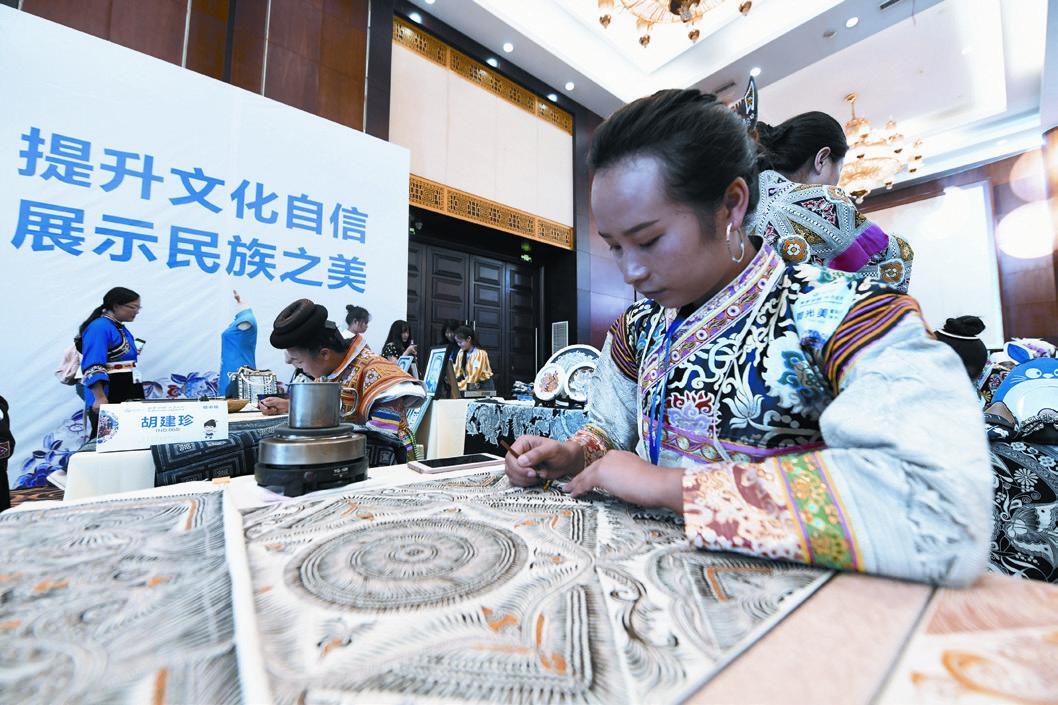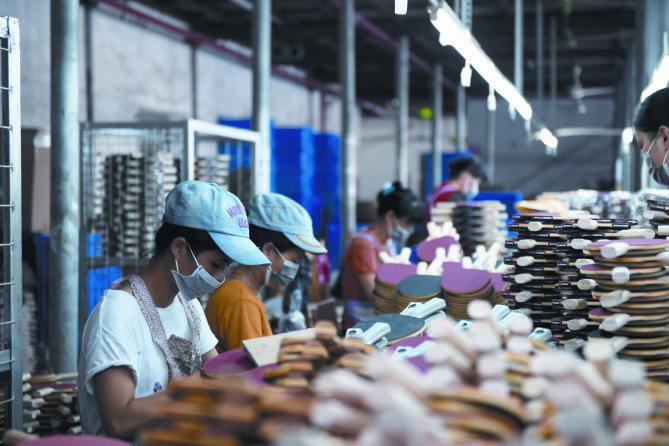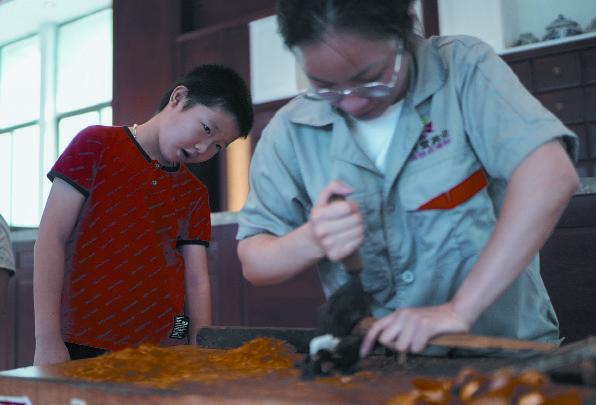Fruit Feast

Fruit Feast
Tourists feed Asian elephants during a public awareness activity on World Elephant Day in a tourism area in Xishuangbanna Dai Autonomous Prefecture, southwest Chinas Yunnan Province, on August 12.
Green Energy
Northwest Chinas Xinjiang Uygur Autonomous Region has transmitted 62.67 billion kWh of electricity generated from renewable sources from 2011 to July this year, according to local authorities.
The electricity, which was mainly generated by wind and solar power, helped reduce carbon dioxide emissions by about 48.88 million tons and sulfur dioxide by more than 60,000 tons, State Grid Xinjiang Electric Power Co. Ltd. said on August 12.
The installed generating capacity of wind power in Xinjiang reached 19.25 million kw, and that of photovoltaic power totaled 10.22 million kw, according to the Development and Reform Commission of Xinjiang. Xinjiang started transmitting electricity generated from renewable sources out of the region in 2011, and large-scale outbound power transmission started in 2014 when a transmission project was put into operation between Hami City in eastern Xinjiang and Zhengzhou, capital of central Chinas Henan Province.
Heritage Protection
The National Cultural Heritage Administration (NCHA) is soliciting opinions from the public for a draft revision to the law on cultural heritage protection.
The draft intends to pool public wisdom on issues including protection of cultural heritage, appropriate use, streamlining the ownership system, social participation and sharing resources, the NCHA said on its website.
Members of the public may submit their opinions via mail, e-mail, and the NCHAs Weibo and WeChat accounts before September 9, the statement said.
The current law on cultural relics protection was adopted in 1982. Its revision was listed in the legislative plan of the Standing Committee of the 13th National Peoples Congress.
Honoring Martyrs
The State Council, or Chinas cabinet, published a revised regulation for commending martyrs, effective on August 9.
Premier Li Keqiang signed a State Council decree to publish the regulation.
The revision is largely related to incorporating the honor system of martyrs into the state-level honor system, a State Council statement said.
The revised regulation adjusts the procedure for identifying a martyr and entrusts a national commission in charge of Communist Party of China and state honors to review the list of martyrs identifi ed by the Ministry of Veterans Affairs.
The statement also asks the governments at the county level and above to hold ceremonies to give the martyrs families the honor certifi cates on Martyrs Day every year to show respect.
Martyrs Day falls on September 30.
Elderly Care
An online platform centering on elderly care was launched on August 8 in southwest Chinas Yunnan Province.
The platform provides information about nursing facilities for the elderly, analyzes the basic information about senior citizens in Yunnan to better meet their demand and is connected to a call center. Online shopping services and mobile applications are also offered.
Yunnans population is aging. By the end of 2018, the province had 6.85 million senior citizens aged 60 and above, said Wang Jianxin, Deputy Director of the provincial civil affairs department.
As of August, 1,228 nursing facilities and community service centers had been connected to the platform.
Disposable Income
Chinese residents saw their percapita disposable income surge by nearly 60 times during the past seven decades thanks to the steady economic expansion.
The per-capita disposable income stood at about 49.7 yuan($7) in 1949, and topped 28,200 yuan ($4,006) in 2018, registering a growth of over 59 times factoring in inf altion, a report released on August 9 by the National Bureau of Statistics (NBS) showed.
The steady income growth also led to a continuous increase in consumption spending. Chinese residents per-capita consumption spending surged from 88.2 yuan($12.53) in 1956 to 19,853 yuan($2,820) in 2018, growing 28.5 times in real terms, NBS data showed.
Ethnic Treasure
A contestant is busy wax dyeing during the Fifth Guizhou Womens Handicraft Competition held in Guiyang, capital city of southwest Chinas Guizhou Province, on August 14. In 2013, a program was launched by the local government to train rural women in embroidery, wax dyeing and other handicrafts, helping them shake off poverty.

Production Safety
The Ministry of Emergency Management on August 8 reported sound production safety records in China in July with fewer production-related accidents and deaths compared with the same period last year.
The ministry reported one less severe accident and 14 fewer deaths compared to the same month last year, while moderately severe accidents and deaths in July were down 24.4 percent and 28.2 percent year on year, respectively.
Chemical plants and coal mines were the most notable sites of production accidents, with 15 people dying in a gas factory blast on July 19 in central Chinas Henan Province, according to an offi cial of the ministry.
Efforts should be made to defuse safety risks, eradicate problems and enforce accountability to prevent accidents in areas such as hazardous chemicals and mines, the offi cial added.
As the country braces for a potential spate of disasters like typhoons, fl oods, mudslides and landslides in August, the ministry also urged local authorities to issue disaster alerts in time and warn production personnel and residents in affected areas.
China introduced a regulation on production safety in April and carried out safety inspections.
Ensuring Safety
An activity destroying illegal guns and explosives is held in Wuhan, capital of central Chinas Hubei Province, on August 12. Chinese police destroyed 107,000 illegal guns and large amounts of explosives in 154 cities.
The destroyed guns and explosives were confi scated by police or turned over to police by their holders voluntarily since last year. The activity on August 12 was the second of its kind launched by the Ministry of Public Security after police destroyed illegal guns and explosives in 146 cities last September.

Judicial Explanation
The Supreme Peoples Court (SPC) is to enforce a judicial interpretation on the review and execution procedures for the death penalty to protect convicts lawful rights and interests, starting from September 1, the SPC announced on August 9.
When delivering the judgment documents to defendants, higher peoples courts should notify the defendants of their rights to be represented by a lawyer when the SPC is reviewing their death sentences, the judicial interpretation stipulates.
The defense lawyer is obliged to submit relevant evidence materials and documents to the SPC within 10 days after the acceptance or designation to be the defense lawyer, and present the statement of defense within 45 days, the interpretation says.
When the statement or evidence may affect the review results of the death sentence, the execution should be suspended or ceased, even if the ruling of the review has been made, according to the judicial interpretation.
The peoples courts should also inform the convicts of their right to meet their close relatives and approve their applications for recording their last words on audio or video devices, it adds.
Requests for meeting convicts under the death penalty by close relatives should be allowed unless the convicts refuse the meeting, the judicial interpretation says, adding that the convicts have the right to ask for a meeting with their friends or relatives other than close relatives on the condition of safety.
The convicts requests for meeting with their minor children should be granted with the consent of the minors guardians and conducted in a way that brings no physical or psychological harm to the minors, it says.
Economy Steady
Facing mounting challenges at home and abroad, the Chinese economy continued to operate within a reasonable range with steady upward momentum in July, Liu Aihua, a spokesperson for the National Bureau of Statistics, told a press conference on August 14, citing latest economic performance data.
In the fi rst seven months of the year, investment in hi-tech manufacturing surged 11.1 percent year on year, 5.4 percentage points faster than total fi xed assets investment growth, while hi-tech manufacturing output rose 8.7 percent, 2.9 percentage points faster than total industrial output.
Exports expanded 10.3 percent from a year ago to 1.53 trillion yuan($218 billion) in July alone and imports went up 0.4 percent to 1.21 trillion yuan ($172 billion).
Excluding auto sales, which were affected by the countrys new emissions standards that came into effect in July, retail sales rose 8.8 percent in July, remaining fl at compared to that in June.
The job market remained generally stable in July, with 8.67 million new urban jobs created in the fi rst seven months, accomplishing 79 percent of the annual target.
Moreover, foreign direct investment (FDI) into the Chinese mainland expanded 7.3 percent year on year in the January-July period, while FDI in July alone was up 8.7 percent year on year, higher than the 8.5-percent growth in June, according to the Ministry of Commerce.
Income Generators
Workers process table tennis bats in a workshop in Xingye County, south Chinas Guangxi Zhuang Autonomous Region, on August 13. To date, 156 workshops have joined the countys poverty-relief employment program, which provides more than 6,000 jobs.

Rubber Futures
Trading of yuan-denominated natural rubber futures, the TSR (technically specifi ed rubber) 20 futures, which are open to overseas investors, started on August 12.
The listed futures at the Shanghai International Energy Exchange are contracts to be delivered from February to July 2020. The benchmark prices of the six contracts were set at 9,260 yuan($1,319) per ton.
The trading margin for each contract is 7 percent of the contract value, while sitting at 9 percent in the initial period.
The daily trading band is 7 percent higher or lower than the settlement price of the previous trading day. On the fi rst day of trading, the limit was set at 14 percent above or below the benchmark price.
The TSR 20 futures are Chinas fourth commodities futures open to both domestic and overseas investors, after the crude oil futures, PTA futures and iron ore futures.
New Partnership
Global investment fi rm KKR & Co., Inc. has bought a majority stake in the Chinese mainland business of NVC Lighting Holding Ltd., a leading lighting products maker in the country.
According to a statement jointly issued by the two companies, once the strategic partnership is set up, KKR will pay $794 million for a 70-percent stake in NVCs China business, while the latter will continue to hold the remaining 30 percent of equity.
“We believe KKR will contribute international resources and operational expertise to support the longterm development of NVC Lighting,”said Wang Donglei, Chair of the Board of NVC Lighting, which was founded in 1998 in the southern province of Guangdong.
China is a core focus of KKRs Asia-Pacifi c strategy. It has invested more than $4.5 billion since 2007 to support competitive local fi rms to develop into industry leaders, according to KKR.
Real Estate Check
The China Banking and Insurance Regulatory Commission (CBIRC) will launch a targeted inspection into banks property-related businesses in 32 cities including Beijing, Shanghai and Shenzhen, to see whether their credit policies are in line with government regulations.
The regulator will also scrutinize banks f niancing services for property and land development to prevent loans to ineligible companies or projects, as well as the implementation of differentiated credit policies for individual housing.
The move came after the Peoples Bank of China, the central bank, called on lenders to keep their loans in the property sector at a reasonable level while increasing credit support for key areas and weak links.
Banks should adhere to the principle of “houses are for living in, not for speculation,” adjust and optimize their credit structures and implement long-term mechanisms to maintain the sound development of the real estate market, the central bank stressed.
Earlier data showed Chinas loans to the real estate sector grew at a slower pace in the fi rst half of the year as purchase restrictions remain in place in major cities.
At the end of the second quarter, the outstanding loans to the property sector stood at 11.04 trillion yuan ($1.57 trillion), up 14.6 percent year on year, according to data from the central bank.
Rich Selections
Tourists from Kazakhstan visit a garment shop at the Horgos International Border Cooperation Center on the China-Kazakhstan border, on August 11.
The worlds fi rst cross-border free trade zone, the facility offers food and beverages from Central Asia as well as textile products and consumer goods made in China. The number of visitors reached 3.34 million in the fi rst seven months of 2019, up 7.28 percent year on year.

Renewable Capacity
Chinas wind and solar capacity additions recovered as recent policies cleared the wait-and-see approach of many renewable companies, Fitch Ratings said in its latest report.
New solar installation recovered in the second quarter as solar projects approved in 2018 were required to start operations before July 2019 to qualify for a higher feed-in tariff.
Meanwhile, wind capacity additions, which were 58 percent higher in the second quarter from the same period last year, are likely to continue to increase throughout the year as wind farm developers are rushing to fi nish projects before 2020 to secure the higher feed-in tariff approved before 2019, according to the report.
The government has since April incentivized grid parity for unsubsidized wind and solar projects.
In addition, the pricing mechanism for subsidized utility-scale solar and wind projects shifted in July from the previous governmentprescribed feed-in tariffs to biddingbased prices, which equals the thermal feed-in tariff plus subsidy.
Knowing Through Seeing
A student watches a staff member cutting dried orange peels, an ingredient of traditional Chinese medicine (TCM), at a plant in Zhangshu, a well-known TCM distribution center in east Chinas Jiangxi Province, on August 13. The visit was part of a program launched by Tianqitang Pharmacy in the city to promote the TCM culture.


